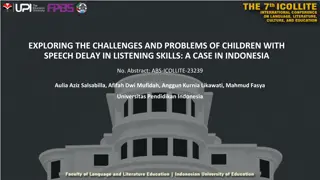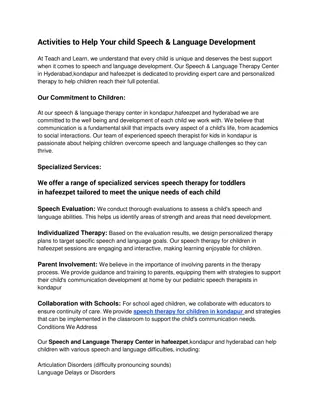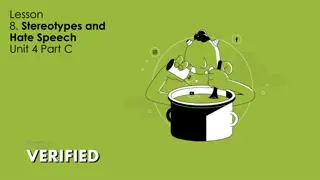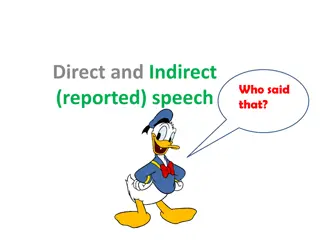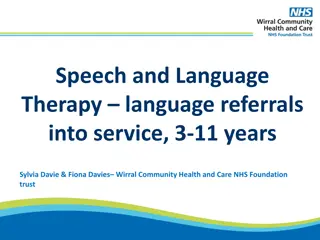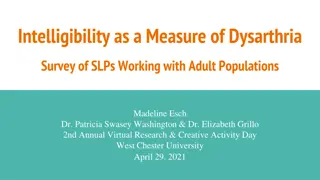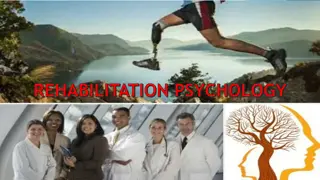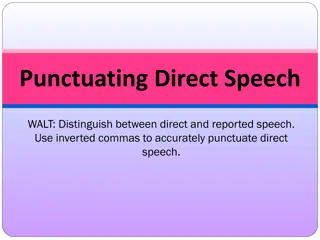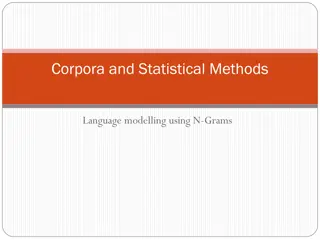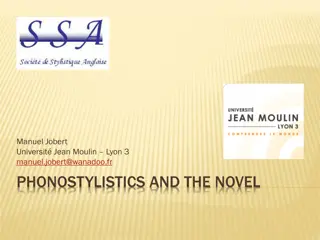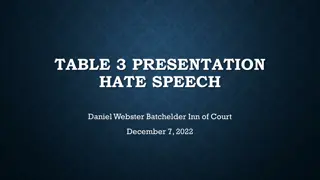Effective Strategies for Speech and Language Interventions in Education
Explore the crucial norms for Zoom meetings, guidelines for speech and language interventions, and the roles of speech-language pathologists in schools. Learn why these interventions are essential, focusing on providing educational relevance, cultural sensitivity, and supporting student progress within the general education curriculum.
Download Presentation

Please find below an Image/Link to download the presentation.
The content on the website is provided AS IS for your information and personal use only. It may not be sold, licensed, or shared on other websites without obtaining consent from the author. Download presentation by click this link. If you encounter any issues during the download, it is possible that the publisher has removed the file from their server.
E N D
Presentation Transcript
Zoom Support Meeting Norms Mute unless you are speaking to the group Use the chat to ask questions Be professional and helpful Be mindful when asking questions about specific situations - don't give out any information that could reveal the identity of a person with a disability
Speech and Language Interventions February 22, 2024
Presenters Beth McKerlie, CCC-SLP NKC Schools, Past President of MSHA Pat Jones, CCC-SLP Liberty Public Schools, Past President of MSHA Diane Cordry Golden, Ph.D., CCC-Aud retired Past MSHA and MO-CASE Board, Past ASHA Committee Chair
Disclosures Presenter Financial Non-Financial Elizabeth Beth McKerlie, M.S., CCC- SLP Employed as SLP & Related Services Coordinator, North Kansas City School District -Member and Past President Missouri Speech-Language- Hearing Association -Member of American Speech-Language-Hearing Association -Past State Education Advocacy Leader (SEAL) ASHA/MSHA Patricia Pat Jones, M.S., CCC-SLP Employed as SLP, Liberty Public Schools -Member and Past President Missouri Speech-Language- Hearing Association -Member of American Speech-Language-Hearing Association -Past State Education Advocacy Leader (SEAL) ASHA/MSHA Diane Cordry Golden, Ph.D., CCC-Aud -Member and past Board member of Missouri Speech- Language-Hearing Association -Member and past committee chair of American Speech- Language-Hearing Association -Member and past Board member of MO-CASE
Why do Speech/Language Interventions? Part of SLP Roles and Responsibilities (ASHA 2010) Ensure educational relevance, highlight language/literacy Work across all levels, serve range of disorders Contribute to curriculum, culturally relevant services Roles and Responsibilities of Speech-Language Pathologists in Schools (ASHA, 2010) Required for Missouri speech/language eligibility criteria The impairment adversely affects the student s educational performance as documented by lack of response to evidence based interventions designed to support progress in the general education curriculum Best practice the right thing to do for students!! IDEA eligible as disabled limited to students who cannot progress in the general education curriculum without special education, related services and/or supplementary aids and services Providing robust speech intervention outside of special education eliminates the need to label a student disabled to receive services (they can be doing fine in the general ed curriculum)
Range of Language Interventions Wide range of language interventions available for districts to use from Consultative support for parent, teacher, para implemented interventions to Robust direct service by SLP or SLP-A in structured program Districts with robust Multi-tiered System of Supports (MTSS) typically fold language interventions into that structure Tiers similar to those used for academic and behavior interventions Can overlap with academic interventions, especially pre-literacy skill development Currently cannot use solely for Language eligibility (limited to LD in MO)
Range of Speech Interventions Similar wide range of speech interventions available for districts to use - consultative to intensive direct services. Many districts have a robust, structured program, similar to Tier 3 intervention level of Multi-tiered System of Supports (MTSS) with Response to Intervention (RtI), that delivers non-special education direct speech services by SLP or SLP-A Program may or may not be part of larger district system of MTSS/RtI Typically different program structure than academic, behavior and language MTSS tiers Many program names - Speech Improvement Program, Speech RtI, Speech Club, Speech Early Intervening Services, etc. (Caution IDEA EIS requirements) Currently cannot use solely for Speech or Language eligibility (limited to LD in MO) Term Speech Improvement Program will be used here to identify this robust, structured direct service program from the wider range of speech interventions.
Myths about Speech Improvement Programs SLPs can only serve IDEA eligible students IDEA funding very small; no need to use for SLP positions IDEA explicitly authorizes SLP to do prevention Speech therapy is exclusively an IDEA service in schools Speech Improvement Program services can look identical to IEP services Speech Improvement more flexible and appropriate to meet most sound system errors IDEA requirements inconsistent with typical speech intervention practices (lack of progress dismissal) Caseloads will increase These interventions should not add onto existing caseloads Students should be served via interventions instead of IEP District will lose money No change in IDEA funding Only impact could be Medicaid (which would be small)
Legitimate Issues to Consider . . . Interventions are not an effort to deny or avoid IDEA rights Implement procedures to use screening for identification Follow IDEA procedures when parent requests evaluation Implement procedures for progress monitoring Implement systematic communication with parents Interventions are not an effort to reduce SLP positions Same number of students typically served Remember there are NO caseload requirements for K-12 Workload should be used rather than caseload Caseload includes all students served (IEP and Speech Improvement) Separate Special Ed Structures - ECSE and Special School Districts
Typical Speech Improvement Program Procedures Speech Improvement Program is for articulation, voice, fluency Language interventions are usually part of preliteracy/reading MTSS structure. Use sound system eligibility as general guide applied to screening data but not binding. Simple consent form with parent signature documenting this is NOT special education. Report progress to parents in some way (standard form or SLP determined.) Services are fast paced and can be quickly changed to meet student needs. Implementation (time/frequency/location) of services determined by SLP. Students may be seen individually, grouped with other speech improvement students, or mixed with IEP students. Students can float in and out of services as needed. Special education students (with an IEP) can receive speech interventions. Needs are reviewed on an ongoing basis and permission forms for speech improvement are done annually.
Support for Speech Improvement Program Special Education and Building Administrators must understand goals and be supportive Remember this is NOT adding to the current duties of an SLP or SLP-A but rather a re- organization of the current workload Caseload data is reported within district in two numbers, those with IEP and those served as speech improvement. Many districts start a stand-alone Speech Improvement Program prior to having a formal MTSS/RtI system in place. This can continue even if the district begins an MTSS/RtI initiative and would be considered more of a Tier 3 intervention level after Tier 1 and Tier 2 supports are provided Most districts do not use federal IDEA funding, thus is not EIS per IDEA and data is not reported to DESE.
Speech Improvement Program Outcomes Districts with robust speech improvement program have less than 1% speech incidence rate (child count) SLP time more balanced, spending as much time on language and literacy interventions and services as speech interventions/services SLP time more balanced between special education and general education activities, can increase critically needed support for literacy development (phonemic awareness skill development, etc.) SLPs have more flexibility, able to intervene with intensive services and adapt services quickly to meet individual student needs SLPs know it is not their responsibility to fix every bad /r/ and /s/ they hear . . .
Language As a Basis for Academics/Education language skills provide a solid base for learning listening and speaking vocabulary is important to development of reading and writing vocabulary language occurs throughout the student s day - it does not occur in a vacuum in the speech room language is the basis for literacy decoding and comprehension are dependent on strong language skills
MTSS (& RTI) Provides the framework for SLP to work in area of prevention Serves to satisfy ASHA s Updated 2010 SLP Roles and Responsibilities for SLPs working in schools Affords and opportunity to further utilize collaboration and consultation service delivery models as part of a viable workload approach to SLP s roles and responsibilities
SLP Activities in MTSS/RTI Framework Tier 1 Screening, observations of students Provide language rich in-classroom lessons/activities Consultation, education, collaboration activities with teams, teachers, parents Suggesting classroom accommodations/modifications Connect communication skills/language underpinnings to curriculum standards Tier 2 Assist teams in selection of research-based interventions Participate in training others to provide interventions to students; provide interventions Assist teams in interpreting data Tier 3 All items listed in Tier 2 with consideration of increased intensity and/or the need for referral
NKC Schools MTSS One of the earliest MO districts using RTI for IDEA eligibility determination of learning disabilities rather than discrepancy (2004) In 2005 adopted procedures for RTI for speech/voice/fluency one of the first MO districts to do so - Speech Improvement Instruction Program (SIP) In 2009-2010, possibly the first MO district to adopt procedures to include SLPs within an RTI approach Rationale to account for the SLPs role and responsibility to help school teams understand the language underpinnings and critical speech/language skill development to enhance literacy, academics and behavior skills Year long research by a task force Established universal speech/language screener, procedures for interventions, flow chart, forms, etc. (SLP Language Intervention Toolkit) Professional development for problem solving teams and SLPs Language eligibility criterion honored and was not used as a delay in refer In 2014-2015, moved to MTSS terminology, incorporated PBIS, social, behavioral
NKC Schools SLP Role in MTSS Become involved in an MTSS model (Tiers 1, 2, 3) (collaborate with team as a consistent team member) Use a screening measure to identify students who might have speech-language concerns (Tier 1) (focus on Kindergarten grade level and on academic benchmark screener performance; ensure hearing and vision is intact for academic interventions) Provide consultation and collaboration to classroom teachers (Tier 1) (General Education Strategies document, observations in classrooms) Provide language enrichment sessions in the classroom (Tier 1) (SLP Resource Library) Provide checklists to classroom teachers to further identify language skill performance in classroom (Tiers 1, 2, 3) (collaboration) Provide consultation and collaboration for academic & behavioral interventions (Tier 2) through MTSS team (consider specific speech-language interventions to augment) Interpret data, provide more intensive interventions (Tier 3) (progress monitoring)
NKC Schools MTSS & Interventions Routine speech/language screenings as part of MTSS compliance plan SLP is part of schools MTSS data review team includes speech/language progress monitoring MTSS Teams consider how speech/language skills impact academic/educational progress to determine when interventions are needed Any staff member can implement the intervention once trained by SLP parents daycare at the EEC level
Benefits of SLP Participation in MTSS Immediate implementation of interventions Data collected is authentic; reviewed regularly; can be utilized in eligibility decision if ultimately evaluated Ability to work with students who may not otherwise qualify for services o Post pandemic concerns SLP observes/interacts with typical students more frequently Helps connect communication skills to literacy and helps further define SLP role in literacy - connect decoding, phonemic awareness, and phonology to language Provides opportunity to practice collaborative and consultation service delivery models Improves collaboration with general education teachers Improves SLP knowledge and understanding of the language demands of the curriculum Improves opportunities for generalization of skills Reduced paperwork Helps others understand what an SLP does, provides greater visibility of SLP and awareness of communication disorders
Comparing Interventions in NKC Schools SIP Requires signed permission form Definite ending and beginning meant to be short-term; cycles (8 weeks) Focuses on a single sound error (no educational impact) SLP provides intensive drill for errored sound; goal (begins with end in mind); progress report MTSS Follows Tiered process begins with Tier 1 interventions in classroom Tier 2 or 3 interventions requires notice of intervention (same notice letter as academic/behavioral) Teacher documents in Educlimber; data collected and analyzed for trend Ongoing for as long as needed; progress and data determine next steps Required as part of an IDEA evaluation process to consider speech or language impairment Parents, teachers, SLP, SLP-A, or any other trained staff member can provide interventions If it is a single sound articulation error, sometimes the best place to start is by having the student complete an intervention on their own after SLP trains student
A word about Progress Monitoring Commercial products for language intervention progress monitoring are limited due to expansive nature of language - i.e., use the SLP expertise Employ progress monitoring procedures that facilitate data driven decisions - Evidence-Based Practices Utilize graph to depict aim/goal line, trendline, etc. Consider frequent checks of the fidelity of implementation of the intervention
Liberty Public Schools - RtI Started RtI services for Speech, Voice and Fluency 2005-06 school year Speech error(s) (Missouri Designated Normative Data) Fluency difficulties Voice differences (Best practice: ENT consult or medical clearance) That have no adverse educational impact, RtI speech services can be provided by the SLP. After speech screening, and the SLP determined the student has non-developmental sound error(s) (Using the MO Sound System Disorder Normative Data Chart), fluency difficulties, and/or voice differences. The SLP can recommend the student receive RtI Speech Services.
Liberty Public Schools - Speech, Voice and Fluency RtI Procedures RTL Procedures for LPS Teacher and/or Parent concern Parent permission to screen articulation, voice or fluency with vision and hearing Contact Parent and classroom teacher with results and recommendations Initiate RtI if indicated with parent permission, Traditional tx, cycles, 5-minute drill,straight speech etc. All of my RtI students have a good understanding of how to produce the phoneme, oral anatomy. Monitored by SLP, Graduate SLPs are excellent for providing services. Services are provided 1:1, in groups with IEP students Communicate with parent and classroom teacher, student s progress RtI might stop if the student lacks motivation, always an option later Parent/Teacher Conferences RtI report If a student transfers to another LPS school the RtI paperwork provided to the new SLP. If a student transfers to another district, the RtI paperwork is provided to the new district.
LPS - Procedures for Language Interventions 1) After a student is brought to TAT and/or Child Study, and there is a language concern from the team, and the classroom teacher has communicated the language concern to the parents. The SLP will send home the Permission For Language Screening form. After the Permission for Language Screening form is returned to the SLP with a signature from the parent giving permission for the screening, the SLP will schedule a time to complete the screening. a) Parent concerns regarding the child s language skills and/or overall development: b) Has the child ever received speech-language services (screening, evaluation, treatment)? Yes or No If yes, please describe: The results of the language screening will be communicated to the parents and classroom teacher. If the student does not pass the language screening activities, specific language interventions will be recommended to the building team. The language interventions might be completed by the classroom teacher, SLP, para, etc., for 6-8 weeks. Interventions are added to Panorama. The results of the language interventions will be communicated to TAT and/or the Child Study team with follow-up recommendations. The team determines if they suspect a disability. 2) 3) 4) 5) 6)
Language Interventions Results of Screening indicate specific language intervention Receptive Language Vocabulary Auditory Comprehension Basic Concepts Problem Solving General Information, DOW, MOY Expressive Language Syntax Sentence Completion Hierarchy of Language Processing Skills: Labeling, Functions, Associations, Concepts, Antonyms, Categorization, Synonyms, Similarities, Differences, Multiple Meanings, Idioms and Analogies. Your Child s Communication https://www.asha.org/public/speech/development/kindergarten/ Example of Language Intervention Add Language Intervention data to Panorama to track progress
Evidence-based practice (EBP) Evidence-based practice (EBP) is the integration of Clinical expertise/expert opinion The knowledge, judgment, and critical reasoning acquired through your training and professional experiences Evidence (external and internal) The best available information gathered from the scientific literature (external evidence) and from data and observations collected on your individual client (internal evidence) Client/patient/caregiver perspectives The unique set of personal and cultural circumstances, values, priorities, and expectations identified by your client and their caregivers When all three components of EBP are considered together, clinicians can make informed, evidence-based decisions and provide high-quality services reflecting the interests, values, needs, and choices of individuals with communication disorders. American Speech-Language-Hearing Association (ASHA)
Evidence-based practice (EBP) Evidence-based practice (EBP) is the process of applying current, best evidence (external and internal scientific evidence), patient/student perspective, and clinical expertise to make decisions about the care of the individuals you treat. This page will teach you this versatile process so you can be confident that you're providing the best possible care no matter what clinical questions may arise. Step 1: Frame Your Clinical Question Step 2: Gather Evidence Step 3: Assess the Evidence Step 4: Make Your Clinical Decision
Language Interventions - LPS Language interventions are provided weekly for 6-8 weeks 4 or more data points. I usually collect data weekly Enter data points into Panorama or document Data is reviewed, questions to be answered? Does the student require more interventions Are the interventions working, do we need to make changes to the interventions? Do we suspect a disability?
SLP SERVICES IN SCHOOLS Apply clinical procedures to educational environment Provide educationally relevant services that support the curriculum Create a shared responsibility for student success (interprofessional practice)Work at the top of the license - activities that are unique to SLP such as maximize skills for language and literacy, supervision of support staff, consultation, etc. (see ASHA)
Workload vs. Caseload The concept of workload encompasses all of the work activities you perform that benefit students directly and indirectly. Caseload refers only to the number of children seen by speech-language pathologist as part of the individual education program (IEP).
ASHA 3:1 model in the school setting Direct services are conducted for 3 weeks in a row, followed by indirect services and activities in the 4th week. IEPs reflect the service frequency (e.g., [direct service minutes 3 /month] Identify a Comprehensive Set of SLP Roles and Work Activities 1. Direct services to students 2. Indirect services that support students education program 3. Indirect activities that supports students in the least restrictive environment and in the general education curriculum: 4. Activities that support compliance with federal, state, and local mandates and activities that result from membership in a community of educators
Workload Activities Chart Direct Services Group/Individual IEP Goal(s) Direct Therapy Monitor progress Assessment of Student Initial Reevaluation 3 year re-evaluation Compliance and documentation Progress Notes Medicaid Billing Attendance Log-optional Specialized Assistance Monitor AAC device Monitor Hearing Aids
Workload Activities Chart Indirect Services Support General Education Curriculum Plan and prepare therapy to align with general education curriculum Consult with classroom teacher Collaborate with other professionals Provide staff development Attend staff development Maintain licensure and National Certification Observe student in general education setting Review compliance standards Parent/teacher conferences Referrals to other agencies Compliance and Documentation IEP review and development RED/consent to evaluate meeting Formal/informal assessments Write evaluation report and/or test write up Progress reports
Workload Activities Chart Indirect Services cont- Specialized Assistance Participate in TAT/Child study teams District-wide screenings Programing/monitoring AAC devices District Leadership teams Other Supervision of student interns/Clinical Fellows Response to Intervention (RtI)
How to start the workload process Administration support Change weekly minutes to minutes per month Planning and organizing for school year In-direct weeks, scheduled for the year Educating parents, staff and students Monthly SLP/SLP-A meetings Workload/caseload form with #students, evaluations, RtI/IEP, student with IEP and RtI students are counted on workload Workload/caseload spreadsheet ASHA Workload Calculator https://www.asha.org/slp/schools/workload-calculator/
Interventions as part of IDEA Evaluation Include a test template called Response to Intervention to document DESE Standard & Indicator 1500.10, 1600.10, 1700.10 or 1800.10. In this test writeup: (1) describe the details intervention (dates, frequency, duration, who provided, setting, etc.) (2) utilize a chart to show data obtained (3) analyze the data - lack of response, made improvements, etc. (4) include behavioral and qualitative information that is pertinent to the implementation of the intervention
Resources American Speech-Language-Hearing Association (ASHA) https://www.asha.org/practice/service-delivery- resources/ American Speech-Language-Hearing Association (ASHA) https://www.asha.org/practice-portal/professional- issues/caseload-and-workload/ American Speech-Language-Hearing Association (ASHA) https://www.asha.org/slp/schools/workload-calculator/
Thank you for your time. Department of Elementary & Secondary Education secompliance@dese.mo.gov 573-751-0699 Pat Jones pat.jones@lps53.org Diane Cordry Golden diane.c.golden@gmail.com Beth McKerlie beth.mckerlie@nkcschools.org
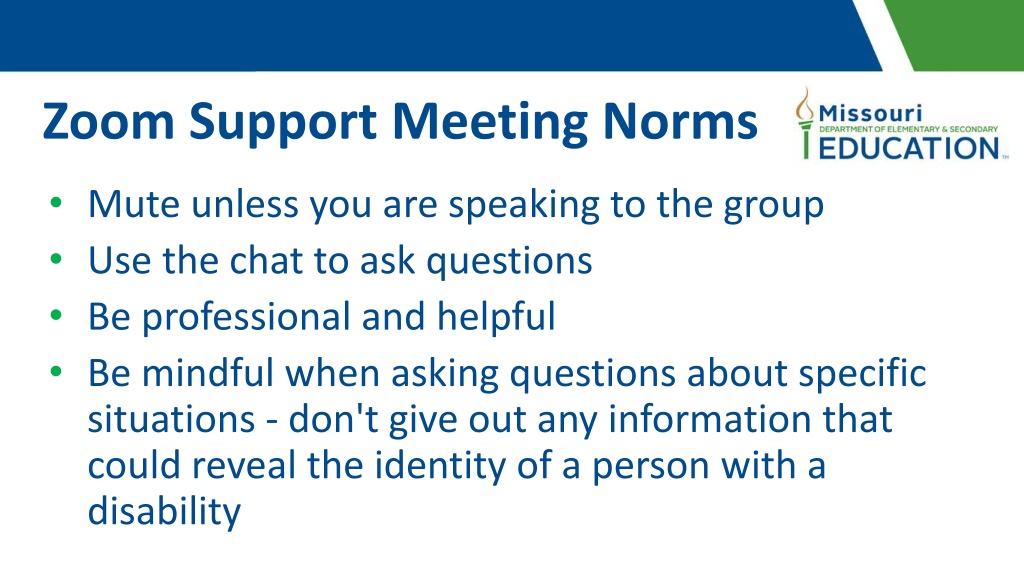

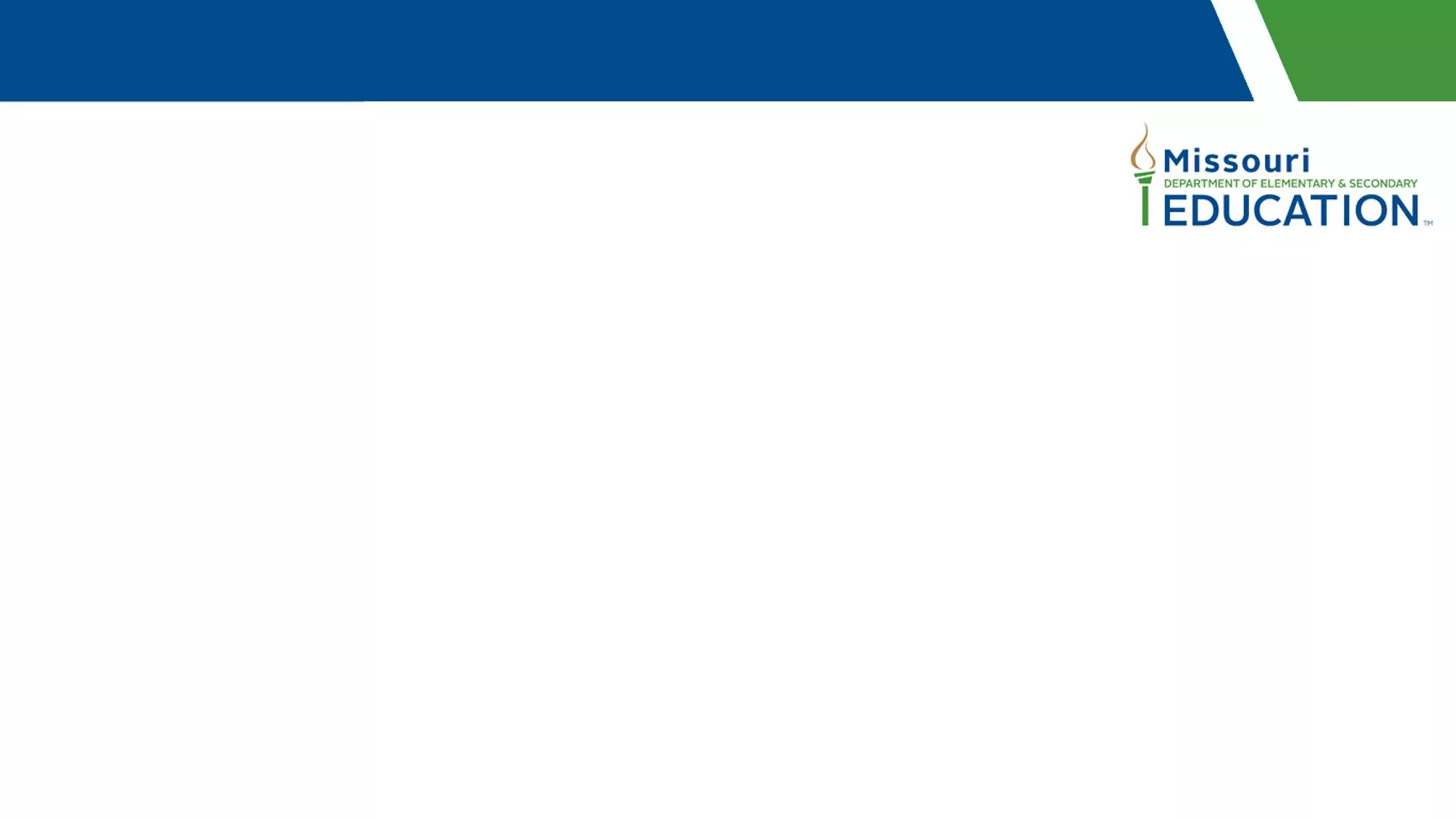


![Prevention and Combating of Hate Crimes and Hate Speech Bill [B.9B.2018]](/thumb/60513/prevention-and-combating-of-hate-crimes-and-hate-speech-bill-b-9b-2018.jpg)
